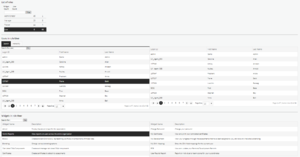Creating Templates Associated to Roles
To create a template for individual Roles you first need to understand which Pages are potentially available for the user to access, and their associated features and functions:
Pages
The following pages are available:
- About – Displays the about screen for the application, information such as application version, etc.
- Admin Reports – The 3 standard administrator reports installed by default are the following:
- User Result Detail – User assessment results, with ability to drill down to question level and the option to export the data.
- User Feedback Response Percentages – User feedback response results, reported as the percentage of users who selected specific responses.
- Question Response Summary – Overall summary, by assessment, at question or criteria level, or percentage of users who selected specific answers or ratings
- Branding – Application branding settings, including color scheme, font size and logo.
- User Field Mapping – Control which user fields can be used for filtering DNA data.
- Feedback Deployment Model – Feedback model management – control who can access a user’s feedback assessment, for example, Self & Manager, Self, Manager & Peers etc. A feedback assessment is created using one of the feedback models once it has been assigned to a user and it will automatically assign the assessment to the next user in the model such as manager or peer.
- Feedback Results Report – Individuals or combination, (for example manager and individual/self) ratings by specific/selected criteria.
- Import Users – Import user details and Hierarchy.
- Manage KPI Data –Manage KPI data to be used within DNA and SkillsAnalysis.
- Knowledge Nudge Report –Knowledge Nudges time and usage results – when, and how long, a user accessed a knowledge nudge. Knowledge nudges are reading material or other information associated with specific assessments. A user may have access to the knowledge nudge prior to taking the assessment.
- Licensing – Performance DNA license information, including the number of licenses and expiry date.
- Assessments – Create, modify, import, export and assign assessments.
- Certificates – Create certificates to associate with assessments.
- DNA Sequencer – Create and edit DNA Strands / Sequences (combinations of measurable metrics within a job role), representing Job Roles and/or components of those roles.
- Base Data Definitions – Create and manage DNA Base Data (KPIs and assessment scores that are part of a DNA Strand).
- Groups – Groups of users that are assigned specific assessments.
- Roles and Widgets – Define permissions and system feature/function access for users.
- System Settings – Create user fields and field mappings (including login field) for all users.
- Users & Hierarchy – Organizational structure and user data. The hierarchy defines the structure within the organization - for example positions and associated users. The hierarchy defines reporting visibility - for example, it defines which users User X can see in a report.
- My Development – Employee visibility and access to any assigned assessments.
- Reset Tests – Reset User Tests.
- Skills Analysis –Correlation analysis of KPI data and assessment results used to identify the skills that are driving performance.
- SkillsRoute – Updates employee skills and associated skills data in Genesys via excel spreadsheet file transfer.
- Top DNA Agents – View employee performance rankings and compare employee performance across an organization or at other levels as selected/desired.
- Update Routing Skills – Link routing Skills to DNA, to allow updating of Skill data from Performance DNA to Genesys.
- User Results Report – User assessment results at individual or manager level, for individual, team, group, site or other filtered criteria. Note: Non-managers can only view their own user results.
- View Filtered DNA – View DNA across your organization, filtered in various ways.
- My Certificates – View and print individual completed certificates.
- My DNA Mapping – Show the DNA mappings for the selected user.
- Messaging Log – Show logs produced by the Performance DNA Email Notification Service
- Trend Graph – Show changes in individual/team DNA data over selected date range.
- Change Password – Change password
- Learning Items – Create and edit Learning items
- Manage Import templates – Manage the list of import templates used for importing KPI data
- Manage Knowledge Nudges – Create and manage Knowledge Nudges. Knowledge Nudges are reading material or other information associated with specific assessments. A user may have access to the Knowledge Nudge prior to taking the assessment.
- Manage Reports – Upload, edit and delete Crystal reports
- Report Categories – Manage Crystal report categories
- User Selections – Manage DNA User Selections that can be used in other pages, for example The Trend Graph
- View Reports – View Crystal reports
Portal widgets may also be available if you have applied a Portal license.
Once you have identified which pages are required to be accessed for which role, they can then be associated to that role.
To associate pages to a role, first select the role from the List of roles and then click the Widgets tab in the selection box (Widgets are the Page names).
Right click the required widget and select Add to role.
Users can create their own tabs and associate the widgets, or create pre-defined templates by role (see next section).
It is possible to set the default page for individual roles by selecting a role and then choosing one of the available widgets for the role from the Default widget for role section located at the bottom of the Roles & Widgets page. The default widget will be the page or feature that opens automatically when the user logs in to the system.



